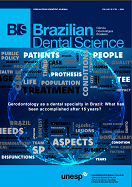Impact of malocclusion on oral health-related quality of life in Brazilian children with cleft lip and palate.
DOI:
https://doi.org/10.14295/bds.2016.v19i2.1248Abstract
Objective: This cross-sectional study aimed to evaluate the impact of malocclusion on the oral health-related quality of life (OHRQoL) in Brazilian children with non-syndromic oral clefts at tertiary craniofacial center. Material and methods: Sixty-nine children with non-syndromic oral clefts, aged between 8 and 10 years, were selected and divided into groups according to the cleft type: Group 1 – Children with complete unilateral cleft lip and alveolus; Group 2 – Children with unilateral cleft lip and palate; Group 3 – Children with cleft palate. Each child answered the Child Perceptions Questionnaire8-10 (CPQ 8-10) which is a multiple-choice questionnaire, with 29 questions on the impact of oral diseases on the OHRQoL. Then, a visual examination of dental occlusion was carried out. Kruskal-Wallis and Mann-Whitney tests were used to determine statistical significant differences among groups (p<0.05). Results: No statistically significant differences were verified for the impact of cleft type (p=0.895) and malocclusion (p=0.528) on OHRQoL of Brazilian children with oral clefts. Conclusion: The malocclusion did not impact on the OHRQoL of 8-10 year-old children with non-syndromic clefts.
Downloads
Downloads
Additional Files
Published
How to Cite
Issue
Section
License
Brazilian Dental Science uses the Creative Commons (CC-BY 4.0) license, thus preserving the integrity of articles in an open access environment. The journal allows the author to retain publishing rights without restrictions.
=================




























